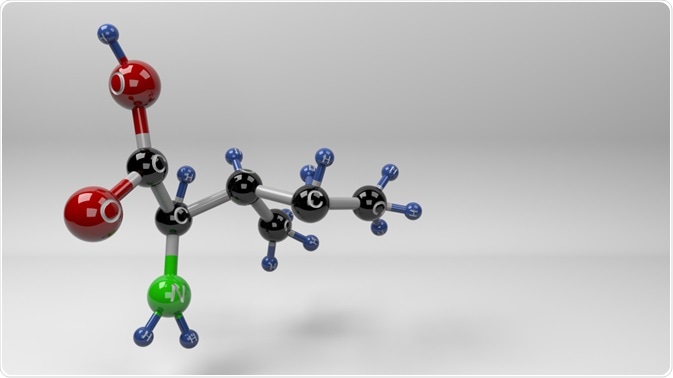As the name might suggest, isoleucine is, in fact, an isomer of leucine. This means that both amino acids have the same molecular formula but differ in structure. Importantly, the two isomers interact differently with other amino acids within mammalian cells. Hence, being able to identify and differentiate between leucine and isoleucine is essential.
 Steven_Mol | Shutterstock
Steven_Mol | Shutterstock
Leucine and isoleucine, along with valine, are known as “branched chain amino acids” and are two of the nine essential amino acids for humans. Branched-chain amino acids are thought to make up 14% of skeletal muscle in humans.
What do leucine and isoleucine do in the human body?
Leucine and isoleucine are transported into organs (including the brain) by the use of L1-neutral amino acid transporter, or LAT1. As other amino acids are also transported by LAT1, leucine and isoleucine must compete for a binding site. Amino acids imported into the brain can be used to synthesize neurotransmitters, therefore changes in amino acid concentrations may have an effect on the neurotransmitters that are made.
Leucine has additional roles; it may inhibit breakdown of muscle, causes the secretion of insulin from pancreatic β-cells, as well as modulate food intake regulation through its action on the central nervous system.
Can leucine and isoleucine be differentiated?
As mentioned before, differentiating leucine and isoleucine could be cumbersome due to the fact that they are isomers. To overcome this, a study by Sowell and coauthors combined liquid chromatography and mass spectrometry on the example of Maple Syrup Urine Disease (MSUD).
MSUD represents a condition where an accumulation of branched-chain amino acids (mostly leucine) is observed in the blood, stemming from a defect in step two of the breakdown pathway. One way of diagnosing MSDU is to analyze blood samples to see how much branched chain amino acids are present. Using liquid chromatography first, the authors showed that it was possible to differentiate leucine and isoleucine.
A similar method was used by Williams and coauthors to also distinguish leucine and isoleucine; a mass spectrometry-based approach using hot electron capture dissociation was employed in this example, with a Fourier transform ion cyclotron resonance mass spectrometer. Here, there is excess energy which leads to extensive fragmentation of the protein (or peptide) being analyzed.
Why is this important?
The study by Williams was looking for variations in hemoglobin, the oxygen-binding protein found in red blood cells. There are disorders which lead to abnormalities in hemoglobin, which can cause serious illness or even death. Identifying these variants would lead to a better prognosis for people with such abnormalities, and the study found a variant by having the ability to differentiate between leucine and isoleucine.
Methylmalonic acidemia (MMA) and propionic acidemia (PA) are metabolic disorders resulting from an inability to break down isoleucine, valine, methionine, and threonine (which are also amino acids), odd-chain fatty acids, as well as cholesterol. These are rare diseases which are known as “inborn errors of metabolism” (IEM).
The restriction of certain foods and the use of medical foods can form part of the treatment for IEM disorders. Leucine is added to a lot of these medical foods, and is hence selected for patients with MMA and PA.
As patients with MMA and PA cannot break down isoleucine and valine, foods containing these amino acids should be avoided. However, it was previously reported that avoiding such amino acids can lead to an imbalance in the amounts of branched chain amino acids in the blood. More specifically, the ratio of leucine to isoleucine/valine was found to be increased.
This could have dire consequences, potentially disrupting the synthesis of neurotransmitters due to impaired amino acid transport into the brain. In this case, it would be pivotal to distinguish between leucine and isoleucine, as the balance between these two amino acids needs to be restored to avoid potential damage.
Further Reading